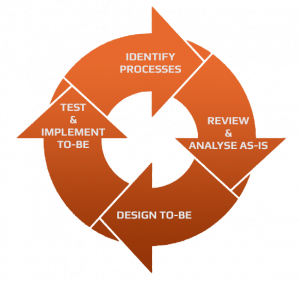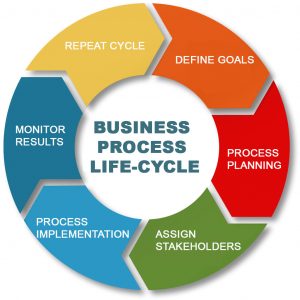Businesses are entering into a new era of technology. In every organization, a business begins with a mission objective and ends with the achievement of the business objective by providing the best output with great customer value. A common mistake many of the entrepreneurs do is that they “just don’t have time” to work on the things that will make them better at what they do.
‘Business process’ is a frequently used term across various verticals and at the same time there is a lot of confusion regarding why it is needed. To have better clarity here are some informations you’ll need regarding what they are, and why your business needs them.
“A business process is a continuous activity or set of sequential activities performed to accomplish a predefined organizational goal. Although the subject can vary, every business process must include clear inputs so that the outputs will be effective. Ultimately, the output must contribute towards organizational objectives by adding value (directly or indirectly) to a product or service.

A business procedure is a clearly stipulated way of undertaking a business process that is planned. A business procedure details the process and the people responsible for each part of the process. It also defines the specifications applicable in each of these phases. Documenting information about various phases of the process in this way allows us to easily share processes, policies and guidance documents among people in our workforce, which is the best way to make sure that the Business Knowledge remains in our organization. In the modern age, a newbie entrepreneur must focus on starting up a small scale business ideas with a non-risky investment bid. Apart from this, this small scale business ideas 2020 is also financially stable and predicted to be profitable.
Smart organizations will not wait for technological advancements to create a need for business process management, instead, they will adopt a process-driven approach to effectively contribute to the organizational goal. However, many organizations fail to achieve this due to a lack of understanding of what exactly a process-driven approach means.
Proper planning and adaptation of the business process can make a massive difference as the team will know who’s doing what, when, and how.
Choosing the best implementation strategy helps to clarify roles, streamline processes and inputs, anticipate risks, and balances the flow to ensure the project is continually aligned with the overall strategy. Process management matters here because without an orderly, easily understandable process, companies risk project failure, attrition of employee trust and resource wastage.

If you are looking for implementing a continuous improvement initiative in your organization, then Business Process Management provides an excellent framework for success. Continuous improvement is a long-term approach in making small improvements gradually over time, as opposed to one big change that occurs all at once.
The first step is to identify what is currently done in the project and then we can put steps in place to make changes to it. If our business processes are truly optimized for efficiency, we will be able to reduce costs and save precious time and money.
The next step is to identify the strategies needed to achieve the goals. This step is very crucial as finding a wrong strategy may have an adverse effect on the goals that you are planning. So, you will need to do good homework before you choose the best strategy.
Once you have a clear overview of all your business processes, you can begin to analyze them to discover the areas that need improvement. For this, we have to identify the individual tasks, that each of your team members needs to do in order to execute the plan. Assigning the right people to do the right tasks would be a tedious task.
The next step would be to run the process on a small scale to see how it performs. Monitor the process execution effectively to notice any gaps that come across and make corresponding adjustments to fill the gap. Next comes the actual execution which will be to start running the process in a live environment. Before reaching this step, the process and the procedures should be detailed properly to all the stakeholders and each of them should be trained in their role accordingly.
Continuous monitoring is needed to review the process and analyze its patterns. Proper documentation is an inevitable step in tracking the process history. This becomes very important when the new stakeholders come into the picture.
If the process is able to achieve the goals set for it, we can assure that we are going in the right way. So, we can strongly replicate it for future purposes.
Once you have set up a process-driven approach for your business, don’t think that you can sit back, relax and see the growth of your business on a positive peak. The current global and competitive business environment constantly seeks innovation and that’s when the existing knowledge base will go obsolete. It’s human nature to struggle with change. However, the cure is to think about adaptability, especially if you find yourself balking at a potential change in your routines.
Business process reengineering (BPR) is the practice of rethinking and redesigning the way work is done to better adapt to the changes and support the Organization’s mission, increase effectiveness and thereby deliver higher quality products to the customer. This also allows a company to reduce costs and improve productivity through newer and more efficient processes.
Before we start with this, the critical step of selecting a BPR team must be done. This team will form the nucleus of the BPR effort and make key decisions and recommendations for the process re-engineering. This team will help to communicate the details and benefits of the reengineering program to the entire organization. Once the team is formed, a thorough business needs analysis must be conducted. The teams must first assess the current processes of the organization and determine what exactly needs to be re-engineered. In this phase, a series of reviews should be held with process owners and stakeholders, regarding the need and strategy for process re-engineering. These sessions help to identify the vision of the ideal business process.
A successful business needs analysis would help in relating the BPR project goals back to key business objectives and the overall strategic direction for the organization. This connection should show the thread from the top to the bottom of the organization so that each person can easily relate the overall business direction with the re-engineering effort.
The reengineering process that is not aligned with the organization’s strategic direction can be fruitless. These initiatives are wasteful and steal resources from other strategic projects. So, the business needs analysis is important in the process as it contributes tremendously to the re-engineering effort by helping the BPR team to prioritize and determine where it should focus its improvements efforts.
BPR should be an ongoing process ad continuous improvement is defined as the propensity of the organization to pursue incremental and innovative improvements in its processes, products, and services.
The incremental change is controlled by the knowledge acquired from each previous change cycle. To ensure that the reengineering effort generates the desired benefits, it must be tested before it is deployed to the end-users. If it does not perform satisfactorily, more time should be taken to modify the process until it does. The BPR team should use feedback loops at every step of the process reengineering. In order to achieve this, we should have an environment that encourages the constant evaluation of results and also a set of individual who takes tremendous efforts to improve.
At ThinkPalm, our risk analysts anticipate & plan for handling risks and are efficient in dealing effectively with any risk when it first occurs. ‘Achieving’ means being better today than you were yesterday, and being better tomorrow than you are today.